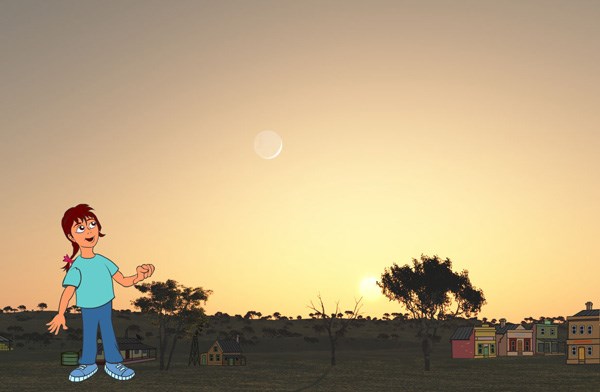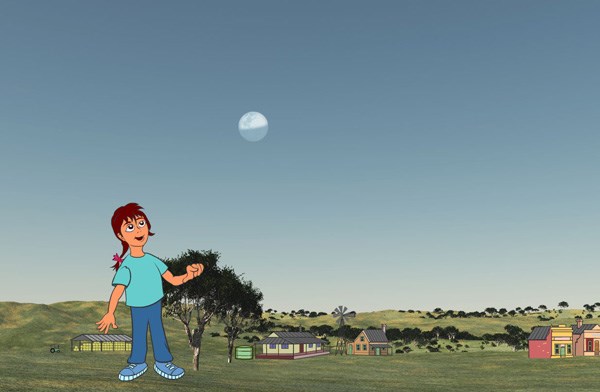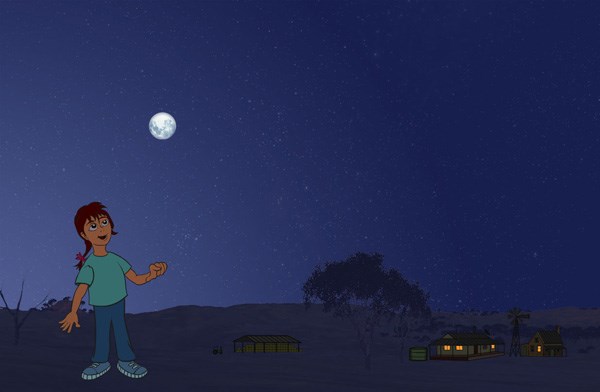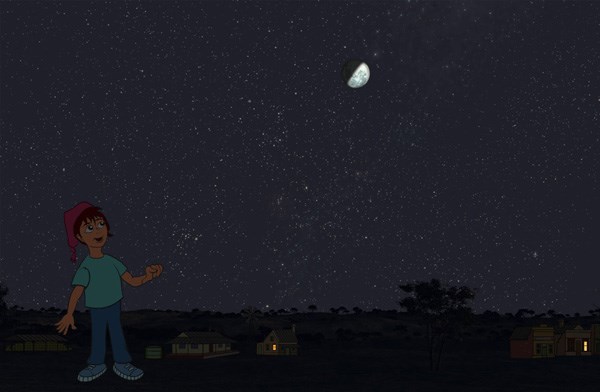Phases of the Moon
This activity is designed to build curiosity about observable changes in the sky, with a focus on the phases of the Moon.
The person depicted in the illustrations below ventures outside at different times throughout the month and notices that the Moon looks different.
Each time the person is watching the Moon rise into the sky, but sometimes this happens during the day and other times at night. The Moon also appears to change shape over time, and this is related to when we can see the Moon in the sky.
New Moon
A New Moon rises above the eastern horizon at sunrise with the sun. On this day the Moon then travels across the daytime sky with the sun. A New Moon is in the daytime sky but we cannot see it from Earth.
On the day of a New Moon, the Moon is located between the Earth and the Sun. A person on Earth cannot see a New Moon because the side of the Moon that is facing Earth is not being illuminated by the Sun.
First Quarter Moon
The First Quarter Moon rises in the middle of the day and can be seen in the daytime sky. Half of the side of the Moon facing Earth is illuminated by the Sun. The First Quarter Moon is also seen against a starry night sky until it sets below the western horizon at approximately midnight, leaving the sky very dark.
Full Moon
The Full Moon rises at sunset and can be seen against a starry night sky. The side of the Moon facing Earth can be seen to be fully illuminated by the Sun. The Full Moon sets early in the morning as the sun is rising.
Last Quarter Moon
The Last Quarter Moon rises above the eastern horizon close to midnight and can be seen against a starry night sky until sunrise. The Last Quarter Moon can then be seen in the daytime sky until it passes below the western horizon in the middle of the day. This last quarter Moon, like the First Quarter Moon, looks like a half-lit globe.
Learning outcomes
Following this activity, students will be able to:
- state that the Moon looks different at different times of the month
- describe a Full Moon and a Quarter Moon
- recognise that the Moon moves across the sky
- recall that sometimes we see the Moon at night and sometimes we see it during the day.
Engage
Explore the supplied digital resources as a class and pose the following questions:
- Tell me a story about each picture describing what you think is happening in each scene. When and how does the Moon change its shape?
- Identify two things in each picture, focussing on the time of day and shape of the Moon. Talk about them.
- Have you ever seen the Moon look different than how it is shown in these pictures?
- Are there times when we cannot see the Moon at all?
Explore
- The person in the diagrams observes that the appearance of the Moon changes over a period of a month. Develop a class hypothesis about why this change takes place.
- If you were the person in the pictures and you stood outside watching the Moon for a couple of hours, what would you notice about it?
- On the day that it is a New Moon, the Moon cannot be seen during the day or at night. Discuss this observation as a class and develop an explanation of why this might be.
Explain
Although this teacher support information provides an introduction to the phases of the Moon, the focus on student learning should be on the making of observations. Teachers may offer some of the following facts if relevant to class discussions:
- As the Moon orbits the Earth, the shape of the Moon appears to change. This is because different amounts of the illuminated part of the Moon are facing us. This changing is called its phase.
- The phase of the Moon is dependent on its position in relation to the Sun and Earth.
- The Moon rises in the east and sets in the west every day just like the Sun. The time that the Moon rises and sets changes throughout the month.
- The Moon is out during the day as much as it is out at night.
- The phases of the Moon start with a New Moon.
Elaborate
- Students can make their own observations of the Moon over a period of a month. Assign groups so that each group makes observations about the sky over the month. Students may collect data via hand-drawn diagrams or by taking digital photographs. End the activity with an exhibition of student work.
- Encourage students to research the different phases of the Moon with the aim of building class mobiles of its different shapes.
Evaluate students' learning
- In a darkened room, model the phases of the Moon by using a light to represent the Sun and a ball as the Moon. Direct students to sit in different locations of the classroom and draw what they see from their point of view. Collect the classroom diagrams and discuss the different observations of the model Moon. The students should be able to observe the different amounts of illumination that represent the different phases of the Moon.



